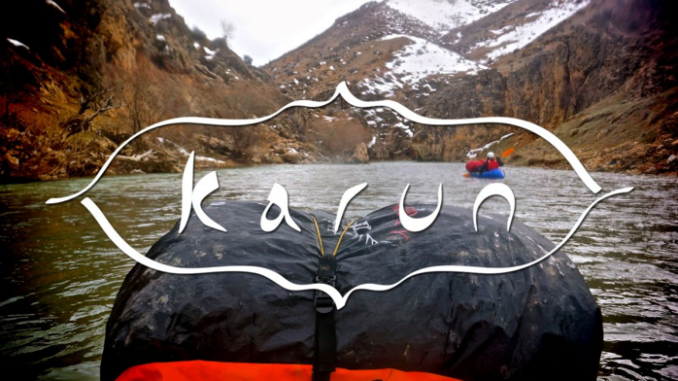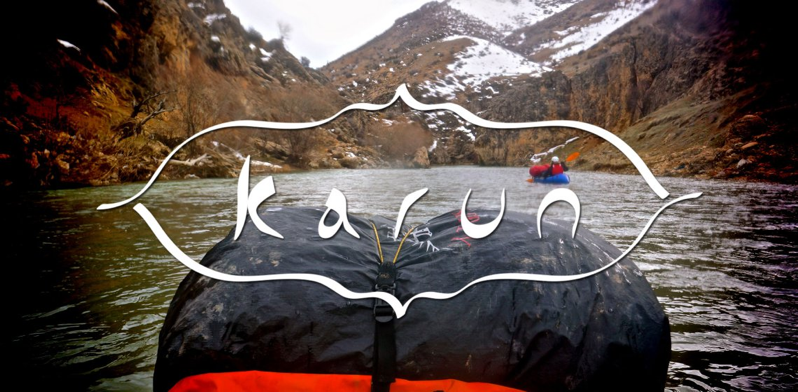
Karun: Misadventures On Iran’s Longest River is a crowd-funded and self-produced documentary charting the course of two British filmmakers and travel junkies, Tom Allen (who previously found some success with Janapar) and Leon McCarron, through the south-west of Iran along the 450 mile Karun River.
Boats, bikes, and inappropriate footwear are all utilised as the pair make their way from one end of the river in the Zagros Range to the other at the Persian Gulf. The film purports to document the true Iran, stripped of Western prejudices. But, by taking influence from the ubiquitous gonzo travelogue TV format rather than more trenchant, cinematic journeys such as Andrew Kötting’s Gallivant, Karun’s focus falls more often on the limited appeal of the well-intentioned, but rather naive, travails of the two adventurers. Karun’s cinematography, shot well despite harsh conditions and a crew of two, can be adept in picking out interesting details and highlighting Iran’s diverse and often spectacular landscape, with immersive use of head-mounted cameras. However, it occasionally seems scattershot and, even when successful, is betrayed by frenetic and unrestrained editing. Often, I found particularly beautiful shots, such as bare and angular trees submerged in the shimmering silver-blue of the river’s reservoirs, snatched away in a blink. To be given glimpses of such fabulous landscapes only to have them flash past your eyes like a whirling dervish feels borderline cruel.

In addition to the hacksaw chop of the edit, the film also suffers under the burden of a tourist visa time limit, of which we are reminded more than once with claims that the filmmakers must move along quickly. During a car ride back to the river after a rafting mishap, one of the many acts of spontaneous Iranian generosity, it is stated by the driver that “Iranians have a lot of time, but no plans.” Allen and McCarron give lip service to the idea that this is a teachable moment in their trip, but it never seem to filter through to the filmmaking. This is perhaps an unavoidable consequence of low-budget and unlicensed production in Iran, but the film and the viewer pays the price. The resulting attention-deficit blitz along 450 miles of spectacular riverside regions becomes less an adventure than a wacky race, even devolving into a pointless and tragically macho endeavour to run the last leg of the journey.
Admitting to the impossibility of effectively conveying the true sense of place of the Karun River’s landscape within their means and time, and shooting accordingly, might have let the filmmakers relax into a more discerning and evocative method of uncovering Iran’s hidden magnificence. The competing styles of endurance travelogue and sincere ethnogeographic documentary just butt up against each other too often to bring about success with either.
On occasions when the film does provide insights into Iran, they are mostly slight and recurrently superficial. In conversations with locals, in the few moments they occur, the mundane and the practical take centre stage, when more notable topics of conversation, such as the juxtaposition between the paranoid, authoritarian state and the friendly, welcoming locals, are waving frantically from the wings.
Perhaps as explanation for this, Allen and McCarron speak to their fears of deportation or confiscation by the police if they were to act like journalists looking into sensitive topics. It may be harsh to criticise low-budget filmmakers for limitations put on them by the authorities, but to come to the country of Jafar Panahi looking to change Western perceptions of Iran and then complain of inevitable restrictions without seemingly any attempt to partake in the famed circumnavigation of rules by Iranian filmmakers, comes off as guileless at best and insulting at worst. Though capable of conversing in Farsi and clearly aware of the misrepresentation of Iranian culture, the pair seem hesitant or incapable of letting the landscapes and inhabitants truly speak for themselves. More often than not we are told by the filmmakers what we are to find important, when the strong imagery and seemingly effusive Iranians are available as a more fulfilling source of significance.
When the filmmakers do latch onto an appropriate focus and rhythm, the film shows some promise. As to culture, there is talk of the vital importance of poetry to Iran and an impromptu folk singalong over tea. For landscape, there’s perceptive mention of how historically Iranians have adapted to the changing nature of the river as we follow it, culminating in the most successful sequence of the film at the remarkable Roman-Persian hydrolic architecture of Shoushtar. Sadly, moments like these fly by in the constant forward momentum of the trip.
Without the stated aim of the duo to present “an authentic look at the geography and culture of Iran” and offer an alternative to the frequently poor representation of Iran abroad, the film would perhaps work as a breezy and entertaining hour of intrepid travel in the company of amiable and earnest companions. Unfortunately, with lofty goals comes high expectations, and Karun simply can’t walk its own line.
Karun: Misadventures On Iran’s Longest River is available digitally at https://karunfilm.com/download/ and you can find worldwide screenings at https://karunfilm.com/screenings/
by Kieran Gosney

Leave a Reply